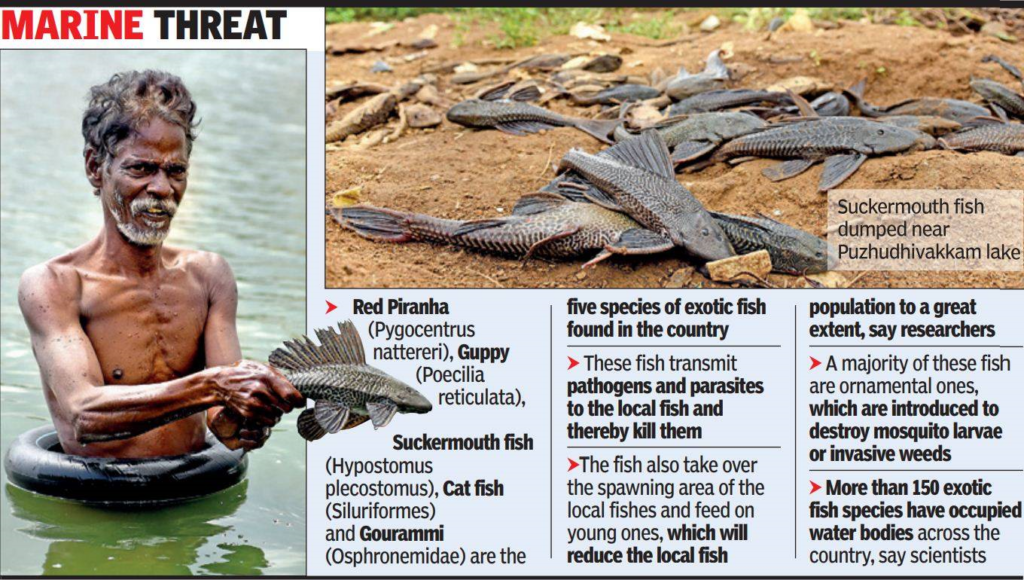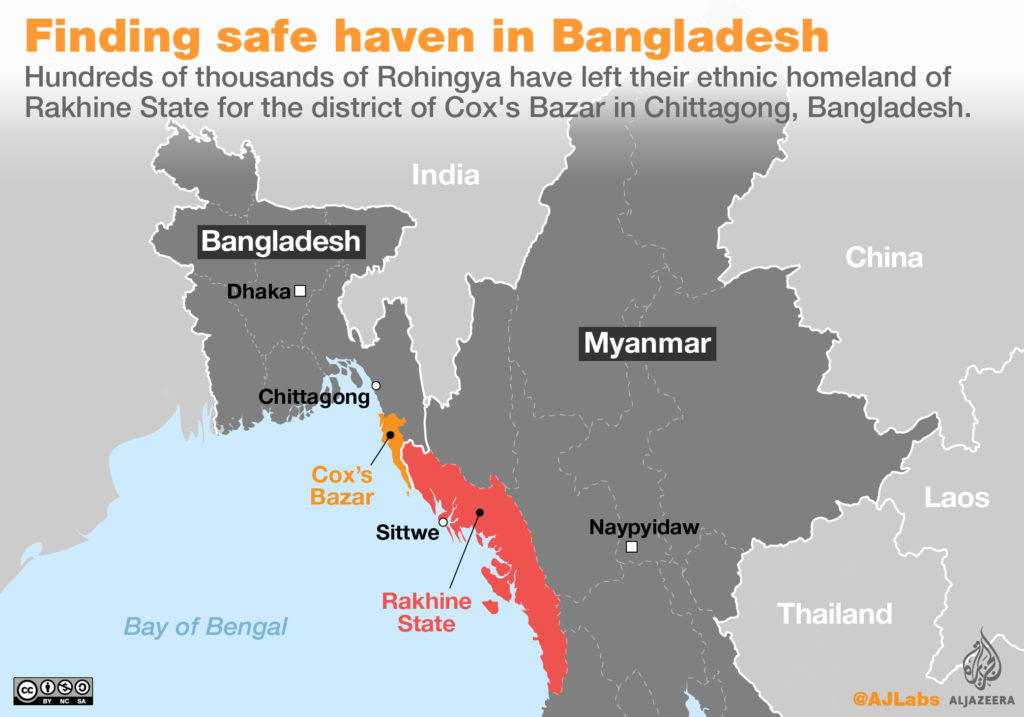Contents:
- NATIVE VS INVASIVE
- LACUNAE IN INDIAN LABOUR LAWS
- ROHINGYA CRISIS
NATIVE VS INVASIVE
Why in News?
- Recently a study revealed the role of the 2018 Kerala floods, in introducing the most dangerous fish species, such as arapaima and alligator gar, into Kerala’s wetlands.
- During heavy floods, invasive alien fishes which are illegally farmed in fragile systems, including domestic aquarium tanks, ponds, lakes and abandoned quarries, effortlessly escape from captivity and enter nearby wetlands.
- Eventually they wipe out the local diversity and the economy by altering the functions of the ecosystem.
- Even after being aware of the impact of invasive species, NO State or Union Territory has any strong policy or law on the illegal rearing, breeding and trading of such invasive ornamental and commercially important fish species.
Details
- In Tamil Nadu – illegally imported ornamental and commercially important fish species are stocked and bred using small cement cisterns, earthen ponds, plastic-lined pools etc.
- The seasonal monsoon floods in the area wash away the exotic breeding stocks and adult fishes into freshwater bodies.
- Exotic ornamental Amazon sailfin catfish poses a serious threat to the native fish species of Vandiyur Lake, Madurai. This species does not hold any commercial value; therefore, people discard the species on the banks of the lake where it is not even scavenged.
- More than 15 exotic ornamental species have successfully established a reproductive population in our freshwater bodies and we still don’t know the magnitude of the impact of this species on the native diversity of fish.

What are invasive species?
- An invasive species is a non-native organism that causes ecological harm after being introduced to a new environment.
- Once they enter a new ecosystem, they can outcompete native organisms for resources like food, especially if they lack natural predators.
- Some invasive species also carry diseases that kill native organisms and many will consume native plants and animals.
- Invasive species can ultimately cause the decline or extinction of native species, decreasing biodiversity in an ecosystem.
LACUNAE IN INDIAN LABOUR LAWS
Why in News?
- The “private power” of
employers to unilaterally fix wages, extract overtime, manage leaves,
determine compensation, etc. has substantially increased with the steady
withdrawal of the state from regulation of labour-capital relations that exist in work-places
like:
- Anaj Mandi in bustling North- Delhi,
- Real estate construction site in Borivali, Mumbai
- Garment factory in Tiruppur, Tamil Nadu,
- Brick kiln in Gaya, Bihar
indicate the non-existent regulation of labour conditions in micro, small and medium sized industrial and commercial establishments
- The workers are mostly migrants, and tend to work long hours for meagre wages. Often, they are crowded into living quarters inside the production unit itself
- The problem lies with growing paradigm of self-certification by employers of their compliance with labour laws, and the tweaking of many statutory labour laws on occupational safety standards, work hours, minimum wage, compensation, industrial disputes, etc. by successive governments, both at the State and Central level.
Extra Coverage:
Why Labour Reform?
- Labour reforms essentially mean taking steps in increasing production, productivity, and employment opportunities in the economy in such a manner that the interests of the workers are not compromised.
- Labour is in the concurrent list and more than 40 central laws and more than 100 state laws govern the subject.
- Labour laws remain extremely complicated and there is a need to bring reform by addressing some of the issues like long-term contracts and dispute resolution.
- The codification of labour laws will remove multiplicity of definitions and authorities leading to ease of compliances without compromising wage security and social security of workers.
- It simplifies access to numerous provisions of the law by all stakeholders concerned.
- It would help in increasing women participation in labour force and address gender-biases in wages.
- It would increase job creation by streamlining labour issues and making hiring easy for industries by developing adequate means to absorb labour in the economy.
Concerns
- The definition of worker is not clear in the Wage Code Bill.
- The calculation of the level of minimum wage by an expert committee is at variance with ILO parameters.
- A ‘national minimum wage’ is a good idea, but its computation is cause for concern. Instead of a single national minimum wage, the bill proposes multiple minimum wage structure at different geographical zones.
- The Industrial Relations Code of 2017 has evoked strong reactions, as the right to form unions and accord them powers of representation have been severely curtailed.
- It provided that a minimum of 10% of workers or 100 workers employed in an establishment or industry would be needed – from seven at present – to register a trade union.
- It further sought to increase the limit for prior permission of the government for lay-off, retrenchment and closure to 300 workers, up from 100 at present. This has been the most controversial provision.
- “The Occupational Safety, Health and Working Conditions Code, 2019” is also being protested by trade unions for allegedly diluting workers’ safety provisions instead of strengthening them.
- All the central trade unions have expressed their displeasure and have demanded thorough consultation and recasting of the Code. They want it to be reviewed by the department-related Standing Committee of Parliament in consultation with them.
- Balancing the interests of employers and workers is a challenging task. Employers want the right to fire in order to hire more, which is strictly opposed by the workers’ unions.
- Also, employers subvert their constraints by hiring contract workers instead of regular workers whom they would have to pay more.
- Informal nature of economy where large number of workers are in the unorganised sector and out of the social safety net is a major issue to be resolved.
- Lack of enough skilled workers is a common concern raised by the employers in defence of their inability to hire more.
ROHINGYA CRISIS
Why in News?
Case regarding The Genocide in 2017 committed by the Myanmarese military on Rohingya Muslims of Rakhine valley, Mayanmar – was taken to International Court of Justice (ICJ) by a tiny west-African state Gambia on behalf of the Organisation of Islamic Cooperation.
Background
- Rohingya is ethnic Muslim minority group, largely comprising Muslims living primarily in Myanmar’s western Rakhine state.
- They differ from Myanmar’s dominant Buddhist groups religiously, ethnically and linguistically.
- They practice a Sufi-inflected variation of Sunni Islam.
- They speak Bengali dialect, as opposed to commonly spoken Burmese language in Myanmar.
- Myanmar considers Rohingya’s as illegal Bengali immigrants, despite fact that many they have resided in Rakhine province of Myanmar for centuries.
- Myanmar government even refuses to grant them citizenship status, and as a result they do not have any legal documentation, effectively making them stateless.
- They are also restricted from freedom of movement, state education and civil service jobs.
- UN has often described Rohingyas as one of the most persecuted minorities in the world.
Details
- The preliminary hearings of the case at ICJ seeking guarantees of basic protection for Myanmar’s Rohingya Muslims, arguably offer only symbolic hope to this longsuffering community.
- Following the genocide and ethnic cleansing- 7 lakh Rohingyas fled Mayanmar and entered Bangladesh as illegal immigrants.
- The forces have insisted that their actions were merely in response to the armed insurgency – Arguing on their behalf at the ICJ is – Nobel Peace Laureate and Myanmar’s leader Aung San Suu Kyi.
- The more urgent concern before the ICJ is Gambia’s petition seeking an injunction that the violence against the community cease forthwith and the government guarantee immediate protection.





